QFD: Origin and Introduction
| This book advocates moving the quality-related aspects of development as far upstream in the development process as possible. QFD provides tools and techniques to help with even the "fuzzy front end" of the development process. The Robust Software Development Model (RSDM) presented in this book provides a powerful framework for developing trustworthy software in a time- and cost-effective manner. A key aspect of Specification or Functional Design, performed by systems analysts in concert with the potential end users of the software, is to determine who the targeted customers or intended users are for the software solution we are developing, why the customers or users need a solution (what user problems the software must solve), and therefore what the software should do and how well it should do it. So, what role can QFD play in an RSDM? QFD's contributions to the Seven Components of RSDM are as follows:
In Chapter 2's discussion of the Design for Trustworthy Software (DFTS) process, software quality is defined as the degree to which a system, component, or process meets customer or user needs or expectations. Although all five major components of trustworthy software are areas where QFD can play a role, the most significant area is customer responsiveness. If the software is of no value to the customer, the reliability, safety, security, or maintainability of the software is irrelevant to the customer. Customers are only interested in the trustworthiness of software that is worth something to them. To understand customers' definitions of value, we have to "listen to the voice of the customer"a concept that QFD created and introduced. To develop trustworthy software and to gain customers' trust, we must first meet customers' needs, whether stated or unstated. We must be able to identify these needs correctly on an iterative basis throughout all phases of the software development process. But how can we meet unstated needs? And how can we ensure that our software, when delivered, will actually be trustworthy in the eyes of its users? QFD was created to address exactly such questions. What's Different about QFD as a Quality System?The traditional role of methods such as Statistical Process Control and the DMAIC problem-solving approach of Six Sigma has been to improve the quality of a product or process after it has been produced or established. Methods such as Statistical Process Control (SPC) and the DMAIC problem-solving approach of Six Sigma are excellent in such situations. They can take an existing situation and efficiently reduce "negative quality" such as defects, problems, and variability. In the late 1960s in Japan, Dr. Yoji Akao saw that such methods were not enough, however. Two fundamental insights led to the development of QFD:
These insights ultimately led to the development of QFD as a modern quality system, focused on understanding what value means to the customers or users we intend to satisfy.[1] Therefore, QFD uses tools and techniques that take customer statements and actions as input, in addition to the traditional methods based on measurements of what's wrong with what already exists (see Figure 11.1). Figure 11.1. Traditional versus modern quality systems. Traditional quality-improvement and problem-solving methods focus on reducing defects. Dr. Deming described such approaches as "scraping burnt toast." And even with all defects removed (zero defects), are we assured that our customers will be satisfied? No. Satisfaction is not merely the absence of defects. Rather, satisfaction requires the presence of value, as determined by the customer. Modern quality methods, such as QFD, focus on adding value to the customer, which requires new tools and techniques. Traditional quality-improvement and problem-solving methods use data (measures from an existing product or process) to find the root cause of defects or problems and remove them or solve them. In order to use these approaches, you must first develop somethingthen you can test it and improve it. In contrast, QFD's aim is to understand the customer's needs and use that understanding to drive design and developmentto ensure customer satisfaction on the first pass through development.[2] So, you can use QFD for new-product development, even for the initial development of products and software that are new to a customer, a company, or the world.[3] Further, in contrast to the assumptions of many approaches to software requirements, QFD does not assume that customers understand their needs, or that customers can tell us all of their needs. Note that many iterative or evolutionary development approaches begin with an assumption that it is not possible or practical to get a sufficient set of requirements from customers such that developing to those requirements would satisfy customers. Thus, iteration is used as a strategy to obtain feedback from customers on an ongoing basis in order to redirect the development effort in mid-flight. This series of small build-and-correct cycles allows developers to proceed even when only a weak understanding of what is needed is available (from customers or analysts). The application of QFD tools and techniques to requirements discovery creates a much better understanding of requirements, much more quickly. Therefore, the need for and the number of iterations required during development is drastically reduced (see Figure 11.2).[4] Figure 11.2. Iterative methods alone, and with QFD. Fewer iterations require less effort and take less time. QFD tools, applied to better discovery of customer needs at the front end of the development process, can reduce the number of iterations required, and thus development time and effort. The History of QFDQFD originated more than 20 years ago in Japan for the efficient development of products and services that satisfy customers. Dr. Yoji Akao and other leading quality experts in Japan developed the QFD tools and techniques and organized them into a comprehensive quality system.[5] Organizations throughout North America have used QFD since 1984, with cross-functional teams and concurrent/simultaneous engineering, and on services, products, and the product development process.[6], [7], [8] In certain industries, such as the automobile industry, QFD use is now practically universal. And as companies such as Toyota and Ford demonstrated the effectiveness of QFD, its use in the software industry became inevitable (see Figure 11.3). Figure 11.3. The first 20 years of QFD in Japan and North America. Note that QFD development preceded its use at Toyota in the 1970s and the first use of a matrix came before Mitsubishi Heavy Industry's application at its Kobe shipyards. The first QFD book written in English was Bob King's Better Design in Half the Time, published in 1987. The History of Software QFDWhy apply QFD to software? In almost all cases, software is developed to produce a result for the organization(s) that funded the software's development. And in most of those cases, software is built to satisfy customers, both internal and external. To satisfy customers better (and/or faster), we must deliver value to them more efficiently. To do this, we need a framework for value, and a process to ensure its efficient delivery. QFD was developed over the past 40 years for this purpose[9] and it has been applied to software for almost two decades.[10] In JapanSince 1982, Japanese software organizations have been using QFD with impressive results.[11] Dr. Tadashi Yoshizawa and other leading software quality experts in Japan pioneered Software QFD.[12] NEC IC Microcomputer Systems Ltd., which received a Deming Prize in 1987 for its world-class software-quality efforts, is a sterling example of the power of Software QFD.[13] In 1989, with support from the Ministry for International Trade and Industry (MITI), the Information Processing Promotion Industry Association released a two-volume, 360-page book on Software QFD to further the development of high-quality software by Japanese firms.[14] These impressive efforts to combine sophisticated software engineering[15] with state-of-the-art quality systems, such as QFD, are continuing.[16] In North AmericaSince 1988, North American software organizations have been using QFD.[17] Firms such as AT&T Bell Laboratories,[18] DEC[19], [20] Hewlett-Packard[21], [22] IBM,[23] Texas Instruments,[24] and others have reported good results with Software QFD. QFD has become an essential part of TQM for world-class software organizations[25] and today it is part of DFSS as well. So, What Is QFD and Why Do We Need It?To understand what QFD is and why we need it, it helps to consider a very simple model of the development process.
Now consider two organizations with the same resources and the same time pressures to develop a product to satisfy a customer. Incoherent DevelopmentThe first organization proceeds as usual (see Figure 11.4a). It gathers requirements, documents them in a specification, and attempts to meet all the requirements throughout the development process. But like most software development organizations, this organization does not have enough resources or time to meet all customer requirements and provide best efforts throughout development. Even if the spec notes the high importance of some of the customer's requirements, there is no method to communicate such information to all the developers and through all the phases. Nevertheless, some items in each phase receive special attention, but this decision is made independently by those involved in each step of development; furthermore, by chance, some items that received best efforts in one phase also receive best efforts in a later phase. The result is a product that does not fully represent the effort the team put in, as most of the team's best efforts are wasted by lesser efforts upstream or downstream. Also, the product is strong in terms of meeting the requirements of greatest importance to the customer, but only by luck. Because the results depend on chance, a large organization with many development teams will have a few successes due to good luck, and a few clear failures due to bad luck. In both cases, the efforts of the team are not responsible for the result. Figure 11.4A. An incoherent development process. The boxes on the left represent customer needs. Within each phase, best efforts are applied based on local judgments (and without regard to best efforts in the preceding phase). Over the life of the project, some best efforts align by chance, producing a product with strengths that are not predictable and that align with customer importance only by luck. Without a method to communicate what is most important to the customer end to end, alignment of best efforts to customer priority, and across phases, will be random. Coherent DevelopmentThe second organization proceeds with QFD (Figure 11.4b). It uses QFD to discover the customer's voice and to gather the customer's requirements, including the priority the customer places on those requirements. There are not enough resources or time for all customer requirements to receive best efforts throughout development, so the team concentrates on the small number of high-value requirements. It uses specific formal and informal methods to communicate the high-value needs and their priority to all developers and through all phases. The high-value items receive best efforts in every phase, consistently. Figure 11.4B. A coherent development process. QFD is used to discover truer customer needs including their importance. This is communicated end to end throughout the development process by both formal and informal means, and everyone concentrates their best efforts where it matters most to the customer. The result is a product with predictable strengths on items of greatest importance to the customer: a high-value solution, produced efficiently. The result is a product that shows the team's true capability. They performed at their absolute best, end to end, on the items that mattered most to the customer. For the same amount of resources and time as the first organization, the second organization has produced a result that is clearly superior. And because they used a systematic process to produce this result, they can repeat their success, as can all other development teams in the organization. A Focus on PriorityWhy is focus so important to QFD? In order to satisfy customers when our time and resources are limited, we must be efficient. Consider a customer with many requirements, as shown in Figure 11.5. Figure 11.5. Accurate measurement of requirements priority reveals a Pareto distribution.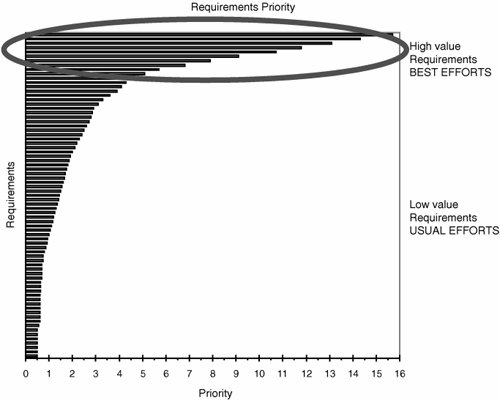 So to improve our development process for greater customer satisfaction, we need to apply our best efforts on the small number of high-value requirements. Much of the effort spent on doing a great job on the many low-value requirements has no impact on customer satisfaction. Some customer needs are more important than others. When the importance of needs is accurately measured, such as with the Analytic Hierarchy Process (see Chapter 8), it is clear from the priorities that a vital few requirements are as much as an order of magnitude more important than the many requirements of almost trivial importance. Performance on the trivial requirements doesn't matter. Only performance on the important requirements has a significant effect on customer satisfaction. With limited resources or time, it is essential to do your best on what matters most to customers. On the many trivial requirements, do what you can, time and resources permitting. Most analysis approaches concentrate on requirement completeness. The assumption is that we should discover, document, and deliver all the customer requirements, and that this will satisfy the customer. In contrast, QFD focuses on requirement sufficiency. The assumption in this case is that if we concentrate our available efforts on the most important requirements, we have our best chance at satisfying the customer. The aim is to deliver a sufficient level of performance on a sufficient number of high-value requirements to satisfy the intended customer. In Software QFD, software requirements of low value, but requiring high effort to develop, will be set aside to free up effort for the high-value requirements.[26] They are intentionally not implemented. If low-value requirements are missing, customers may notice, they may complain, they may even insist they be added in the next upgrade, but they will still buy, accept, and use the software. The customer's interest, choice, and loyalty are won or lost on how the software performs on the small number of high-value requirements. Most requirements will have no significant impact on customer satisfaction because they just aren't that important to the customerthey're of low value. QFD DefinedSo, what is QFD? Japan Industrial Standard Q 9025 defines QFD as follows:
Items from the perspective of new product development are the following:
QFD is a modern quality system composed of deployments (subsystems), each focused on one dimension of the development process (such as reliability). These deployments in turn are composed of a series of tools, organized in a sequence to address the questions and concerns of that dimension throughout the project and the development process.[28] QFD DeploymentsIn this chapter, the term QFD refers to the entire quality system shown in Figure 11.6, not just to the first box, which represents the "House of Quality" matrix. Figure 11.6. Deployments of QFD. QFD is a quality system with many subsystems. Task deployment is the application of QFD to the development process itself. It is used to tailor QFD to a specific organization. Comprehensive quality deployment refers to the QFD activities applied during a project. Specific deployments address the dimensions of development that are important for that project, such as quality, reliability, safety, security, and maintainability in a DFTS organization. The Four-Phase Model of QFDThe four-phase model of QFD was popularized by a Harvard Business Review article, "The House of Quality."[29] Presenting an early understanding of QFD, the model was widely adopted by automotive suppliers, for whom it had been developed. Parts suppliers at the time were operating in a build-to-print environment. Their auto company customers supplied them with a detailed design and asked them to build the corresponding parts.[30] Figure 11.7 shows the four-phase model. Figure 11.7. The four-phase model begins with the "House of Quality" and deploys quality characteristics into parts, the specific equipment to make those parts, and the settings and procedures for those parts-making machines. As this is a tailored QFD process for parts suppliers in a build-to-print environment, no design activities are supported, making this an inappropriate model for software development. When the design is a given and cannot be changed, the only decision a parts supplier needs to make is how to build the part betterhow to best upgrade an existing model of the product. The four phases in this approach are as follows:
At each phase, only the most important items are deployed to the next phase. (Otherwise, the matrices can become unmanageably large.) In this way, QFD is helping the entire production process end to end to focus best efforts on what matters most to the customers. So what is actually conveyed by the "voice of the customer" is not the content of what the customer saidthat changes from customer attributes to engineering characteristics, and so on, to machine settingsbut the importance to the customer, the priority. So across the dimensions of development, represented by the rows and columns of the matrices in the model, the knowledge of what's most important to the customer is communicated. The "House of Quality" MatrixWhen they think of QFD, many people think of the "House of Quality" matrix. So named because it resembles a house (if you use your imagination), this matrix is intended to be the bridge between the world of the customer and the world of the developer. It is here that traditionally the "voice of the customer," or customer needs, are translated into the corresponding quality characteristics and capabilities that the solution will require (see Figure 11.8). Figure 11.8. Components, or "rooms," of the traditional "House of Quality" matrix. When first introduced to North America in the mid-1980s this was how the matrix was described for hardware and model upgrade applications. Today modern QFD uses a more sophisticated approach that leads to smaller and more focused matrices with greater accuracy that take less time and effort to produce. The "House of Quality" matrix is an analysis matrix, and it is created before any design activities are performed. The matrix has several components, often referred to as rooms (listed here in order of completion):
Software QFD does not use the "roof" of the "House of Quality" matrix. The columns in the matrix are software or technical requirementsthe characteristics and capabilities which any solution must have in order to satisfy the customer, and therefore to be a "quality" solution. And these should be implementation free, or devoid of any assumptions of design or implementing technology. (Such design decisions occur later in the development process and are supported by subsequent QFD matrices and tables.) Therefore, the items in the columns cannot conflict, unless we have already created the design or are constrained in what design we can use (as may be the case for an upgrade of an existing product). In order for a conflict to exist, a design or implementing technology must be assumed. For example, in the classic hardware example of a car door, a conflict is presented between "ease of opening" and "sealing against rain". But this conflict exists only with a conventional door design. For tilt-forward doors, as on a Lamborghini Countach or Toyota Sera, no conflict exists. For gull-wing doors, such as on a Bricklin or DeLorean, no conflict exists. Also note that such conflicts are fundamentally physical conflicts, and there are no physical conflicts in software. In software development, when we are making design decisions during the design phase and are choosing which implementing technology to use, it is useful and appropriate to examine logical or design conflictsand the roof can be helpful. But that is in the design phase, not in the analysis phase, and the "House of Quality" is an analysis phase matrix. The "House of Quality" |
EAN: 2147483647
Pages: 394
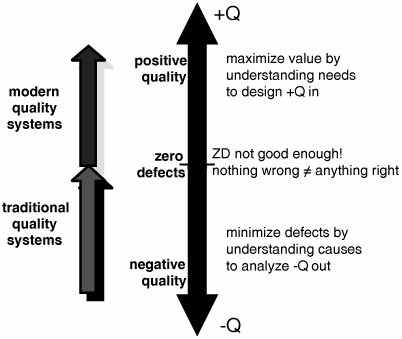
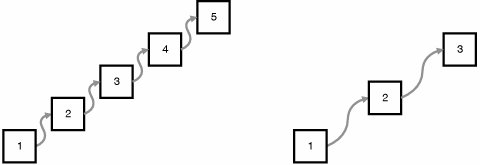

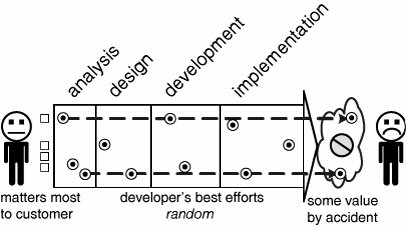
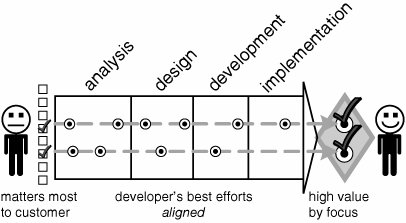
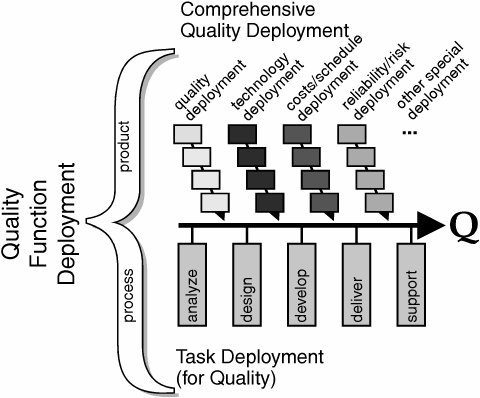
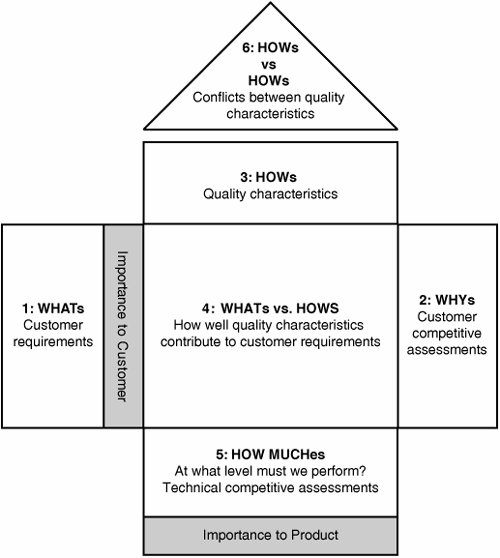
 QFD
QFD